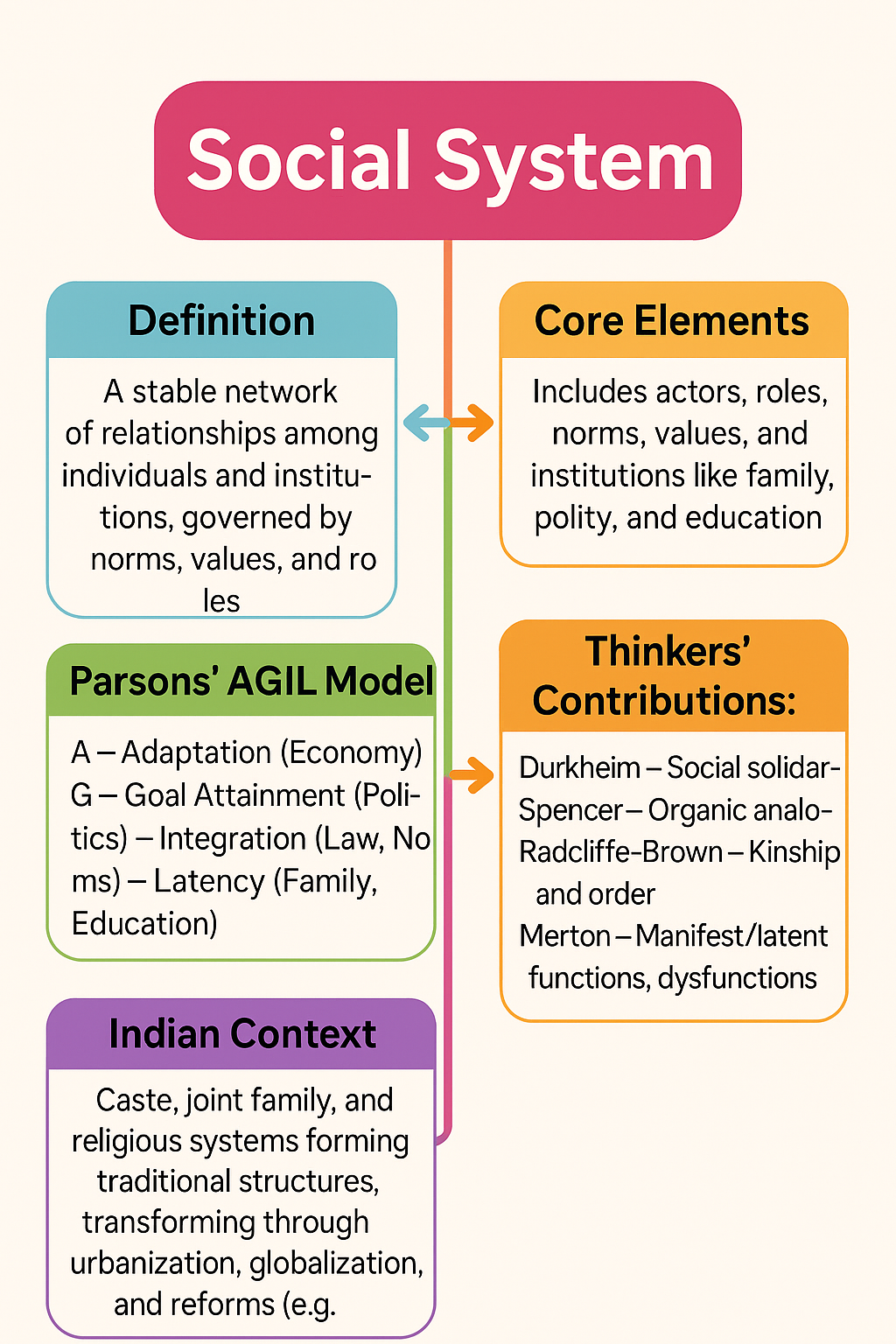Home >> Basic Concepts >> Social Systems
Social Systems
Index
- Introduction to the Concept of Social System
- Structural Elements of a Social System
- Functional Aspects of Social Systems
- Talcott Parsons and the AGIL Framework
- Contributions of Other Thinkers
- Types and Classification of Social Systems
- Mechanisms of Social Integration and Control
- Social System and Social Change
- Social System in the Indian Context
- Critical Perspectives and Contemporary Relevance
- Conclusion

Introduction to the Concept of Social System
The concept of the social system lies at the heart of sociological inquiry, providing a framework to understand how various social structures interact and maintain coherence within society. A social system refers to a patterned network of relationships constituted by individuals and institutions that interact in a relatively stable and enduring way. These interactions are governed by shared norms, values, and roles that facilitate cooperation, integration, and social order. The idea is that society is not a random collection of individuals but a structured whole wherein each component contributes to the maintenance of the system. The concept has evolved from the functionalist tradition, notably in the works of Emile Durkheim and Talcott Parsons, but has also been critiqued and expanded by various other theorists, including conflict and symbolic interactionist perspectives.
Structural Elements of a Social System
Every social system consists of certain structural elements that define its basic character. These include individuals (actors), norms, values, roles, and institutions. The actor is the basic unit of a social system—an individual who performs roles within the framework of expected behaviour. These roles are governed by norms, which are culturally accepted rules of conduct. Values provide the moral and ethical orientation for behaviour, while institutions such as family, religion, education, polity, and economy serve as the structural units within which these roles are played out.
Social systems also exhibit differentiation and stratification. Differentiation refers to the division of roles and statuses according to specialized functions (e.g., the roles of teacher and student), while stratification refers to hierarchical ranking in terms of power, prestige, and resources. These structures are interdependent and mutually reinforcing, enabling the smooth functioning of society.
Functional Aspects of Social Systems
From a functionalist perspective, a social system operates to fulfill the essential needs of society and its members. Functions are the observable consequences of institutionalized patterns of behaviour that help maintain the system’s equilibrium. Social systems have to perform basic functions such as adaptation to the environment, goal attainment, integration of members, and latency (pattern maintenance and tension management).
These systemic functions were formalized most clearly in the work of Talcott Parsons, who argued that all social systems share certain universal requirements necessary for survival. Functionalism views society as a complex system whose parts work together to promote solidarity and stability. Each part of the system has a function that contributes to the continued operation of the whole.
Talcott Parsons and the AGIL Framework
Talcott Parsons stands out as one of the most influential thinkers in the theorization of social systems. In his theory of social action and social systems, he developed the AGIL scheme, which identifies four functional prerequisites that any system must satisfy to maintain equilibrium:
- A – Adaptation: The system must cope with the external environment and allocate resources accordingly. The economic system performs this function.
- G – Goal Attainment: The system must define and achieve its primary goals. This is typically the role of the political system
- I – Integration: The system must regulate interrelationships among its components. This is often the function of legal and normative institutions.
- L – Latency (Pattern Maintenance): The system must maintain and renew the motivation of individuals and transmit cultural values. The family and educational systems perform this role.
Parsons emphasized that these subsystems were interdependent. For instance, economic stability (Adaptation) supports political governance (Goal Attainment), which in turn requires moral integration (Integration) and value transmission (Latency). Parsons’ model provides a macro-level understanding of society, focusing on how stability and order are achieved through interrelated functions
Contributions of Other Thinkers
Emile Durkheim
Durkheim laid the groundwork for the concept of the social system through his emphasis on social solidarity and collective conscience. In his work The Division of Labour in Society, he distinguished between mechanical solidarity (pre-modern societies) and organic solidarity (modern societies), demonstrating how societies maintain coherence through shared values or functional interdependence. Durkheim viewed society as a moral entity greater than the sum of its parts and believed that institutions functioned to maintain social equilibrium
Herbert Spencer
Spencer compared society to a biological organism in his organic analogy, where different parts of society (like organs) have specialized roles and contribute to the overall functioning of the system. For Spencer, a well-functioning society is one in which these parts are coordinated and balanced, promoting growth and survival. His evolutionary approach saw social systems moving from simple to complex forms, just like living organisms.
Radcliffe-Brown
A key figure in British structural functionalism, Radcliffe-Brown saw social systems as self-regulating entities where structures (e.g., kinship systems) existed to maintain social order. He focused on the function of social institutions in maintaining the social structure. For example, in studying kinship systems in tribal societies, he showed how rules of descent and marriage served to bind people into cooperative relationships, maintaining the cohesion of the social system.
Robert K. Merton
Merton refined functionalism by distinguishing between manifest and latent functions and introducing the concept of dysfunctions. Not all components of a social system necessarily promote equilibrium; some may contribute to instability. He also introduced the idea of middle-range theories—a shift from grand abstract systems to empirically grounded analysis. His concept of “reference groups” also emphasized the micro-macro linkage within social systems.
Types and Classification of Social Systems
Social systems can be classified based on various criteria:
- Open vs. Closed Systems: Open systems interact with the external environment (e.g., modern democratic societies), whereas closed systems are more isolated (e.g., traditional caste systems).
- Mechanical vs. Organic Systems: As outlined by Durkheim, mechanical systems rely on homogeneity and shared values, while organic systems depend on interdependence and role specialization.
- Traditional vs. Modern Systems: Traditional systems are characterized by rigid norms, limited role flexibility, and ascriptive statuses, whereas modern systems offer flexibility, role multiplicity, and achievement-based mobility.
Understanding these types helps sociologists analyze how systems adapt, evolve, and respond to internal and external stimuli.
Mechanisms of Social Integration and Control
Social integration refers to the degree of cohesion among individuals and groups within a system. Mechanisms that promote integration include shared values, laws, norms, and institutional roles. Religion, education, and family are critical in this regard. Social control, on the other hand, ensures compliance with societal norms and laws. It can be formal (policing, laws) or informal (customs, peer pressure). Functional theorists argue that these mechanisms are essential for maintaining equilibrium, while conflict theorists critique them as tools for preserving dominance and suppressing dissent.
Parsons viewed integration as one of the four fundamental imperatives of the AGIL model, emphasizing the role of legal and cultural institutions in maintaining systemic coherence. Durkheim, too, emphasized the function of law as a reflection of collective conscience and its role in maintaining social solidarity.
Social System and Social Change
While social systems aim for stability, they are also subject to change. Change can arise due to internal contradictions, technological innovations, cultural shifts, or external pressures such as colonization or globalization. Functionalists tend to see change as evolutionary and adaptive, while conflict theorists (e.g., Karl Marx) view it as revolutionary and rooted in structural contradictions.
Marx, although not a functionalist, contributed to the understanding of how economic systems (base) influence social systems (superstructure). His analysis of capitalism revealed how social systems often preserve inequalities through ideologies and institutional arrangements.
Nikos Mouzelis and Anthony Giddens later attempted to bridge structure and agency through their theories of structuration, emphasizing that individuals are not passive in systems but can influence and reshape structures through action.
Social System in the Indian Context
In India, the caste system has historically functioned as a closed social system, characterized
by ascribed statuses, endogamy, occupational specialization, and ritual ranking. It ensured a
certain kind of stability and role clarity but also institutionalized inequality and exclusion.
M. N. Srinivas highlighted how caste adapted to modernity through the processes of
Sanskritization and Westernization, demonstrating the dynamic nature of social systems.
The joint family system, village community, and religious institutions also serve as
components of the Indian social system. With modernization, these structures have
undergone transformation. For instance, urbanization and globalization have led to the
emergence of nuclear families, diversified occupational roles, and hybrid identities,
reshaping the traditional social system.
B. R. Ambedkar’s critique of caste-based exclusion exposed the oppressive nature of certain social systems and led to constitutional reforms aimed at creating a more egalitarian society. Thus, the Indian social system reveals both the integrative and divisive capacities of systemic arrangements.
Critical Perspectives and Contemporary Relevance
Contemporary sociologists critique classical models of social systems for being overly deterministic and neglecting the role of agency, conflict, and power. Postmodern theorists argue that in a globalized world, social systems are fragmented, fluid, and no longer bound by clear norms or roles. Network societies, digital platforms, and algorithmic governance are reshaping how social systems operate.
Moreover, systems theory has been challenged by feminist scholars who argue that traditional system models overlook gendered hierarchies embedded in institutions like the family and workplace. The gig economy, climate change, and transnational migration further demand a rethinking of static notions of systems
Despite critiques, the concept of the social system remains crucial for analyzing social order, institutional resilience, and the complex interplay of structure and function in society.
Conclusion
The idea of a social system continues to provide a valuable analytical tool for understanding the patterned, institutionalized interactions that define societies. From early structural-functionalists like Durkheim and Parsons to critics like Marx and feminist scholars, the concept has been shaped and reshaped across theoretical traditions. Whether seen as a self-regulating organism or a contested arena of power, the social system helps decode the logic of social continuity, integration, and transformation. As societies become more complex and interconnected, the sociological study of social systems must evolve to accommodate new challenges, contradictions, and possibilities.
References
- Durkheim, E. (1893). The Division of Labour in Society. New York: Free Press.
- Parsons, T. (1951). The Social System. Glencoe: Free Press.
- Merton, R. K. (1968). Social Theory and Social Structure. New York: Free Press.
- Radcliffe-Brown, A. R. (1952). Structure and Function in Primitive Society. London: Cohen & West.
- Srinivas, M. N. (1966). Social Change in Modern India. University of California Press
- Ambedkar, B. R. (1936). Annihilation of Caste.
- Spencer, H. (1860). The Principles of Sociology.
- Giddens, A. (1984). The Constitution of Society. Polity Press.
- Mouzelis, N. (1995). Sociological Theory: What Went Wrong?. Routledge.
A social system basically consists of two or more individuals interacting directly or indirectly in a bounded situation. There may be physical or territorial boundaries, but the fundamental sociological point of reference is that the individuals are oriented, in a whole sense, to a common focus or inter-related foci. Thus it is appropriate to regard such diverse sets of relationships as small groups, political parties and whole societies as social systems. Social systems are open systems, exchanging information with, frequently acting with reference to other systems. Modern conceptions of the term can be traced to the leading social analysts of the nineteenth century, notably Auguste Comte, Karl Marx, Herbert Spencer and Emile Durkheim; each of whom elaborated in some form or other conceptions of the major units of social systems (mainly societies) and the relationships between such units- even though the expression social system was not a key one. Thus, in Marx's theory, the major units or components of the capitalist societies with which he was principally concerned were socio-economic classes, and the major relationships between classes involved economic and political power.
The most influential conceptualization of the term has been that of Talcott Parsons. Parsons' devotion to this issue has two main aspects. First, what is called the problem of social order; i.e. the nature of the forces giving rise to relatively stable forms of social interaction and organization, and promoting orderly change. Parsons took Thomas Hobbes Leviathan, 1651, as his point of departure in this part of his analysis. Hobbes had maintained that man's fundamental motivation was the craving for power and that men were always basically in conflict with each other. Thus order could only exist in strong government. To counter this Parsons invoked the work of Max Weber and, in particular, Durkheim, who had placed considerable emphasis on the functions of normative, factors in social life, such as ideals and values. Factors of this kind came to constitute the mainspring in Parsons Delineation of a social system. Thus in his major theoretical work, The Social system, 1951, he defines a social system as consisting in a plurality of individual actors interacting with each other in a situation which has at least a physical or environmental aspect, actors, who are motivated in terms of a tendency to the optimization of gratification and whose relations to their situations, including each other, is defined and mediated in terms of a system of culturally structured and shared symbols.
The major units of a social system are said to be collectivities and roles (i.e. not individuals as such); and the major patterns or relationships linking these units are values (ends or broad guides to action) and norms (rules governing role performance in the context of system values). Parsons second major interest has been to make sociology more scientific and systematic, by developing abstract conceptions of the social system; one of this points being that even though Weber placed much emphasis upon normative factors as guiding action, there was in Weber's sociology no elaboration of a theoretically integrated total system of action.
Hence the attempt to combine in one framework both a conception of actors in social situations and an overall, highly abstract, outside view of the major factors involved in a social system as a going concern. Various points in Parsons' formulation have been criticized. Notably, objections have been made to the emphasis upon normative regulation, and it has been alleged that Parsons neglected social conflict under the pressure of his systematic perspective; i.e. pre-occupation with system ness and analytical elegance which blinds the sociologist to disconsensus in real life and spurs him to stress integrative phenomena in his analyses. However, it is widely agreed that sociologists should operate with some clearly defined conception of what constitutes a social system. Thus, for many sociologists the term social system is not by any means restricted to those situations where there is binding normative regulation; but in order to qualify as social system it must involve a common focus, or set of foci, or orientations and a shared mode of communication among a majority of actors. Thus, on this basis there can be a system of conflict.

 |
© 2026 sociologyguide |
 |













